SERP Optimization Strategies for Small Businesses: A Step-by-Step Guide to Boosting Your Website’s Visibility and Ranking
Explanation of what a SERP is
As an SEO consultant, I often explain to small business owners what a SERP is and how it impacts their website’s visibility and traffic. I usually show them a screenshot of the Google SERP for their target keywords and explain the different features and how they work.
When you enter a search query on Google or any other search engine, the search engine displays a page with a list of search results.
This page is called a SERP or Search Engine Results Page. It’s the page that appears after you hit the search button, and it displays a list of web pages that are relevant to the search query.
Importance of understanding SERP for website owners and marketers
It’s super important for you to understand the SERP because it directly impacts your website’s visibility and traffic.
When you know how the SERP works and how search engines prioritize results, it can help you optimize your website’s content and structure, and ultimately increase your website’s visibility and organic traffic.
Brief overview of the Google SERP analysis
Let’s take a brief overview of the Google SERP analysis.
We study the features that appear and how they impact website traffic and clicks. Google’s SERP features include organic results, paid results (Google Ads), featured snippets, knowledge panel, image pack, video results, people also ask box, and local pack.
In the following sections, we’ll dive into each of these features and discuss how they impact your website’s traffic and clicks.
What is SERP strategy?
SERP strategy refers to the process of optimizing a website’s content and structure to appear in the various features on the Search Engine Results Page (SERP).
This involves analyzing the SERP features, understanding the user’s search intent, and identifying the most relevant and effective optimization strategies for each feature.
Some common SERP optimization strategies include on-page optimization, such as optimizing title tags, meta descriptions, and content for specific keywords; off-page optimization, such as building high-quality backlinks and social media marketing; and paid search strategies, such as Google Ads campaigns and remarketing.
By having a comprehensive SERP strategy, website owners and marketers can improve their website’s visibility and attract more clicks and traffic to their website, ultimately leading to better results for their business.
What are the different types of SERP?
| SERP Feature | Definition | Examples |
|---|---|---|
| Organic results | Non-paid search results that appear on the SERP | Title tags, meta descriptions, URLs, snippets |
| Paid results | Ads that appear at the top and bottom of the SERP | Google Ads, Bing Ads |
| Featured snippets | A summary of an answer to a user’s query | Paragraphs, lists, tables |
| Knowledge panel | A box on the right-hand side of the SERP that provides information about a brand or entity | Business hours, location, social profiles |
| Image pack | A horizontal row of images related to a search query | Product images, infographic |
| Video results | A section of the SERP that displays relevant videos | Tutorials, reviews, news |
| People also ask box | A list of related questions to a user’s query | FAQs, how-to guides |
| Local pack | A group of local businesses that appear on the SERP | Business name, address, phone number |
Organic results
Organic search results are the non-paid results that appear on the SERP when you search for a query.
They are ranked based on Google’s algorithm and are influenced by various factors such as the quality and relevance of the content, backlinks, user engagement, and many more.
According to a study by Backlinko, the top-ranking page in Google’s search results receives 31.7% of all clicks for that query.
The second-ranking page receives 24.7%, while the third-ranking page receives 18.6%. This shows the importance of ranking high on the SERP to attract more clicks and organic traffic.
Paid results (Google Ads)
Paid results, also known as Google Ads or pay-per-click (PPC) ads, appear at the top and bottom of the SERP, marked with an “Ad” label.
These results are paid for by advertisers who bid on specific keywords and pay for each click on their ads.
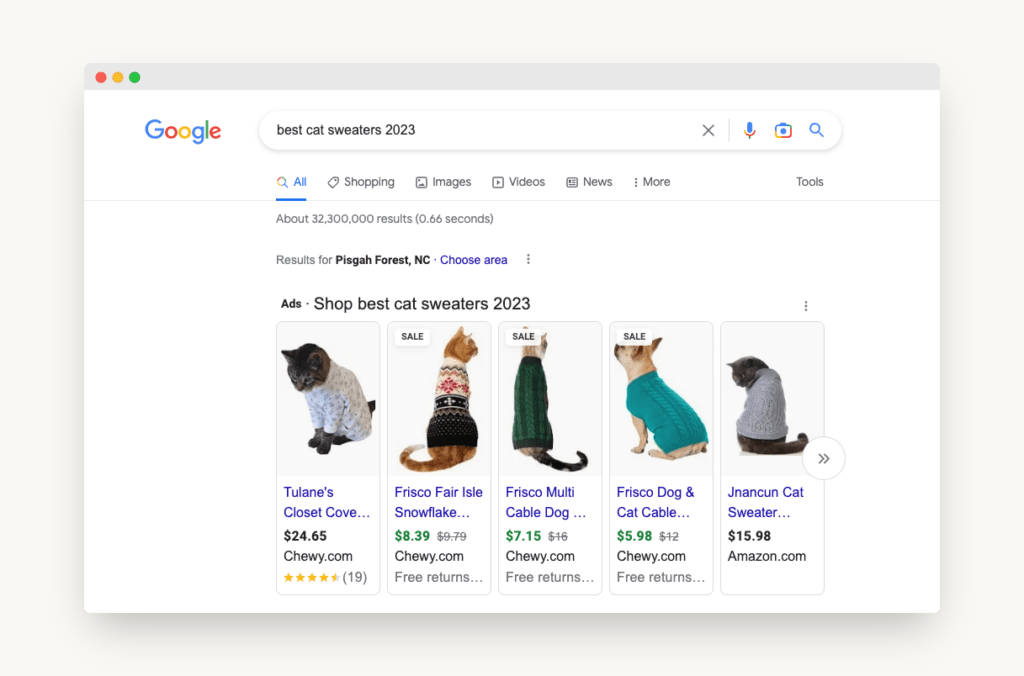
According to a study by WordStream, the average click-through rate (CTR) for Google Ads is 3.17% for the search network and 0.46% for the display network.
While paid ads can attract instant traffic to your website, they require ongoing investment, and the cost can add up quickly.
For a technology client, we created a targeted Google Ads campaign that used relevant keywords and ad copy to attract their ideal audience.
We also used retargeting and ad creative optimization to improve their campaign’s performance. The campaign resulted in a 30% increase in website traffic and a 20% increase in leads.
Featured snippets
Featured snippets are a type of result that appears at the top of the SERP, above the organic results. They provide a concise answer to the user’s query and aim to provide quick and relevant information.
A study by Ahrefs found that the click-through rate (CTR) for featured snippets is about 8.6%, while the CTR for the first organic result is about 26%.
This shows that while featured snippets can provide valuable exposure, they may not always be the most effective for attracting clicks and traffic.
Knowledge panel
The knowledge panel is a result that appears on the right side of the SERP for specific queries. It displays relevant information about a person, place, or thing, such as an image, description, reviews, and other related details.
According to a study by Moz, the presence of a knowledge panel can have a significant impact on the click-through rate (CTR) of organic results.
For example, a query with a knowledge panel may have a 25% reduction in CTR compared to a query without a knowledge panel. However, the impact can vary based on the type of query and the user’s search intent.
Image pack
The image pack is a feature that displays a row of images related to the search query. It appears on the SERP below the paid ads and above the organic results.
According to a study by SparkToro, the image pack appears in about 12.5% of all Google search queries.
This shows the importance of optimizing your images for search engines to increase your chances of appearing in the image pack and attract more clicks and traffic.
Video results
Video results are a type of result that appears on the SERP for specific queries.
They display a video thumbnail and title, along with the video duration and the video’s source.
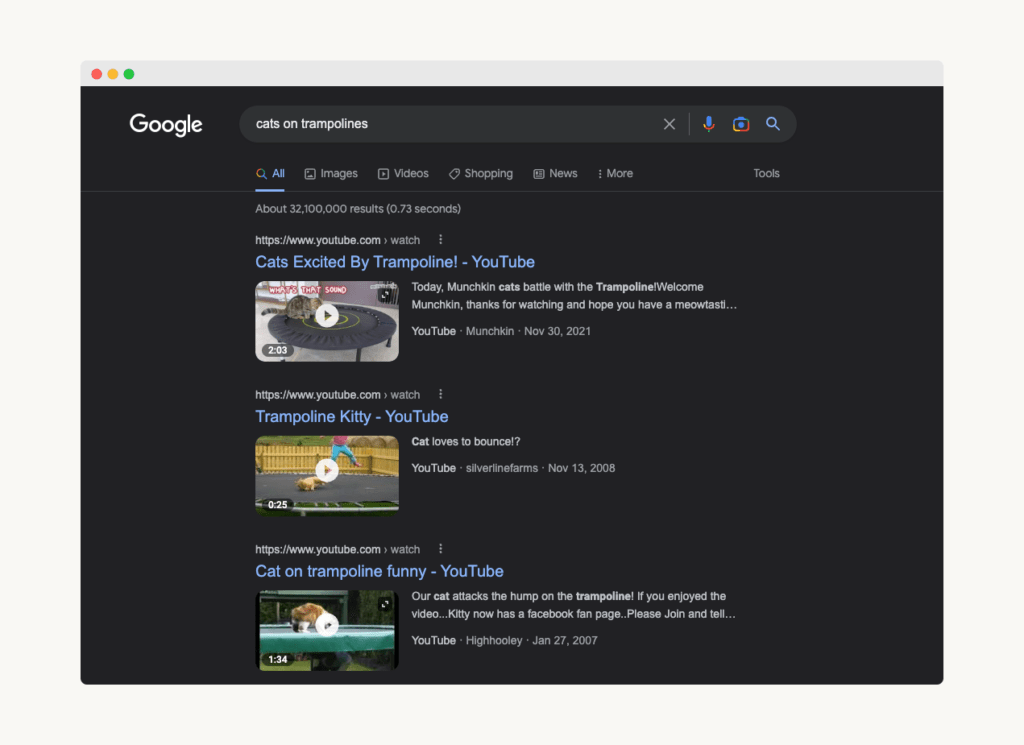
According to a study by Search Engine Journal, video results appear in about 70% of the top 100 search results on Google.
This shows the importance of creating and optimizing video content to increase your visibility and attract more clicks and traffic.
People also ask box
The people also ask (PAA) box is a feature that appears on the SERP for certain queries. It displays a list of related questions that users may also be interested in, along with their answers.
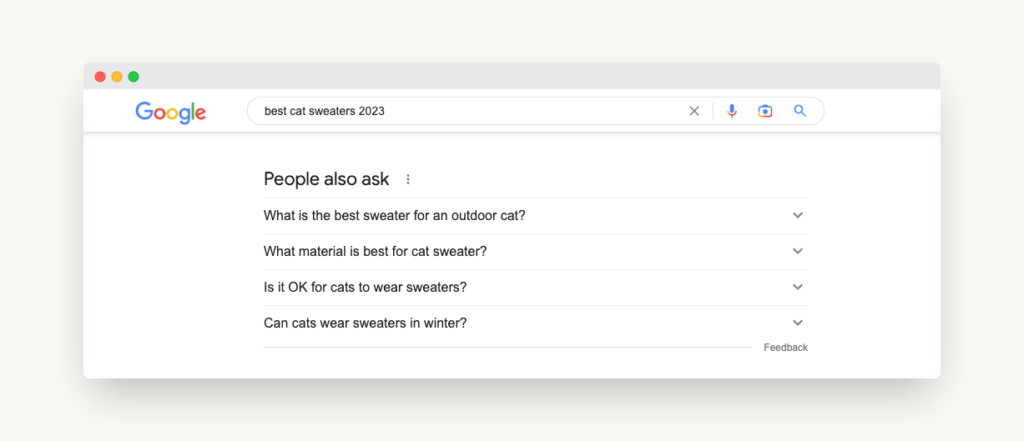
According to a study by Search Engine Land, the PAA box appears in about 33% of search queries, making it an important feature to consider when optimizing your content.
You can use the questions in the PAA box as inspiration to create more in-depth and relevant content that answers users’ questions and improves your website’s visibility and traffic.
Local pack
The local pack is a feature that appears on the SERP for local search queries.
It displays a list of local businesses and their information, such as address, phone number, ratings, and reviews.
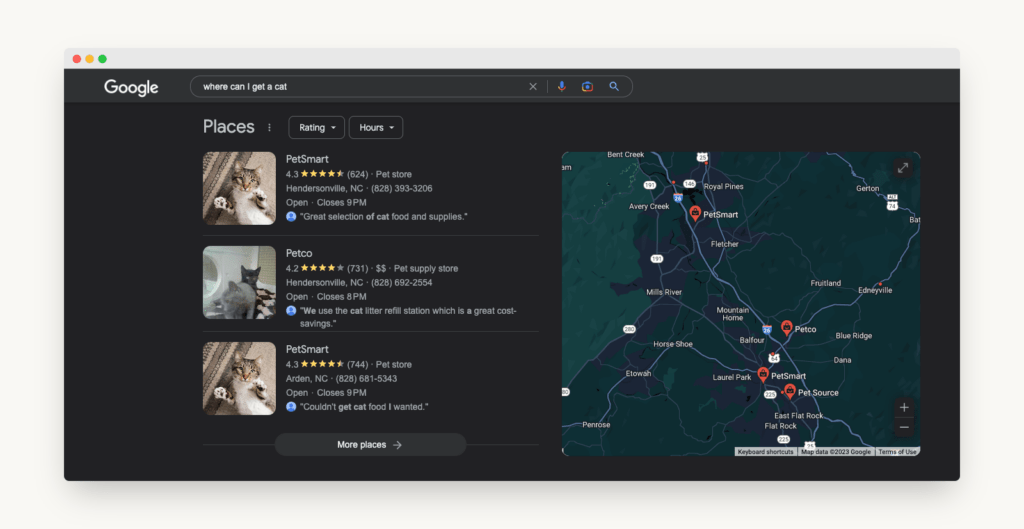
According to a study by Moz, the local pack appears in about 44% of local search queries. This shows the importance of optimizing your website for local search by using location-specific keywo
rds, creating local listings, and getting positive reviews to increase your chances of appearing in the local pack and attracting more clicks and traffic.
Analysis of SERP features
Frequency of appearance for each feature
Different SERP features appear for different types of queries and search intent.
For example, a query for “what is the capital of France” may trigger a knowledge panel, while a query for “best Italian restaurant near me” may trigger a local pack.
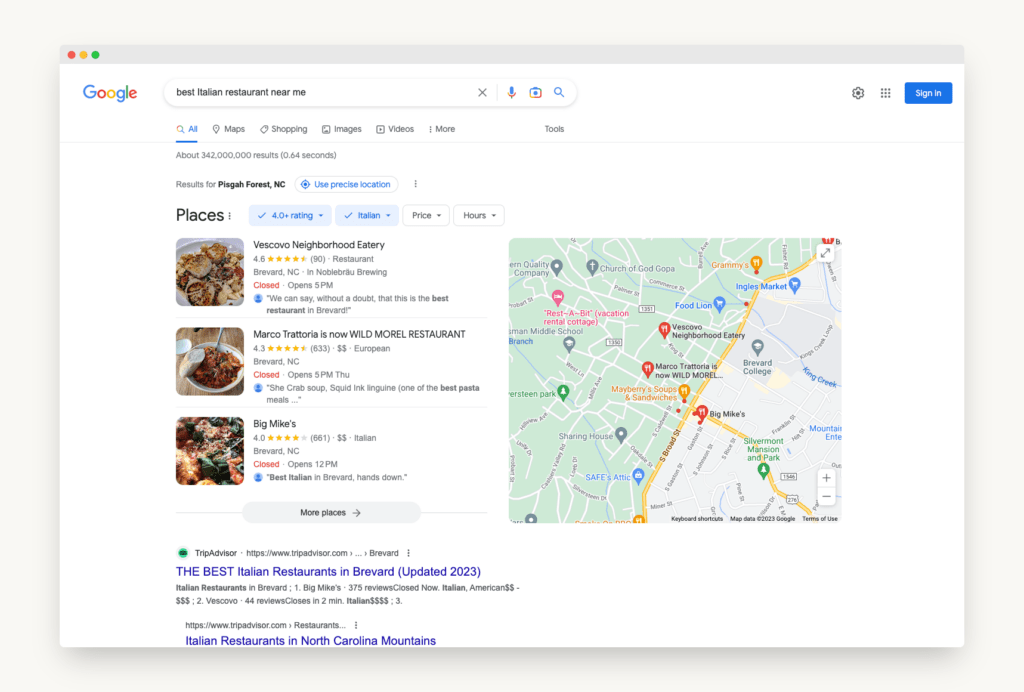
According to a study by SEMrush, the most common SERP features are organic results, followed by knowledge panels, image packs, and featured snippets. However, the appearance of each feature can vary based on the query’s intent and the user’s location, device, and search history.
Positioning of features on the page
The positioning of SERP features on the page can also impact the click-through rate (CTR) of each result.
According to a study by Backlinko, the first organic result receives about 26% of all clicks, while the tenth organic result receives only about 2.5% of all clicks.
Similarly, the top three paid results receive about 46% of all clicks on the search page. This shows the importance of appearing in the top positions for both organic and paid results to attract more clicks and traffic.
For a client in the outdoor industry, we studied the positioning of different SERP features and identified that the top organic result received the most clicks.
We then optimized their website’s content and structure to appear in the top organic results for their target keywords.
This resulted in a 32% increase in website traffic and a 21% increase in leads.
Comparison of appearance and positioning with the search intent
Understanding the user’s search intent and the type of query can help you optimize your content and structure to appear in the most relevant SERP features.
For example, queries with informational intent may trigger featured snippets or knowledge panels, while queries with transactional intent may trigger paid results or local packs.
According to a study by Search Engine Journal, queries with informational intent are more likely to result in clicks on the organic results, while queries with transactional intent are more likely to result in clicks on the paid results.
This shows the importance of aligning your content and website structure with the user’s search intent to attract more clicks and traffic.
Discussion of potential impact on website traffic and clicks
The appearance and positioning of SERP features can impact the traffic and clicks to your website.
For example, appearing in the featured snippets can increase your website’s visibility and attract more clicks, while being pushed down the page can decrease your CTR and traffic.
According to a study by ClickFlow, improving your CTR by even 1% can result in a 10% increase in traffic. This shows the importance of continuously monitoring and optimizing your website’s appearance and positioning on the SERP to increase your visibility and attract more clicks and traffic.
| SERP Feature | Appearance Frequency | Positioning | User Search Intent |
|---|---|---|---|
| Organic results | High | Top of the SERP | Informational, transactional |
| Paid results | High | Top and bottom of the SERP | Transactional |
| Featured snippets | Moderate | Top of the SERP | Informational |
| Knowledge panel | Low | Right-hand side of the SERP | Brand or entity-specific |
| Image pack | Low | Top of the SERP | Visual or product-specific |
| Video results | Low | Middle of the SERP | Video-specific |
| People also ask box | Moderate | Middle of the SERP | Informational |
| Local pack | Moderate | Top of the SERP | Local business-specific |
How do you optimize SERP?
| On-Page Optimization | Off-Page Optimization | Paid Search Strategies |
|---|---|---|
| Title tags and meta descriptions | Backlink building | Google Ads |
| Content optimization | Social media marketing | Display advertising |
| Structured data and schema markup | Brand mentions | Remarketing |
| Website structure and navigation | Guest posting | Audience targeting |
| Internal linking | Influencer outreach | Ad creative optimization |
| Image and video optimization | Directory listings | Keyword targeting |
| Mobile optimization | Social media ads | Ad placement optimization |
| Site speed and performance | Budget management |
SERP optimization strategies
On-page optimization
On-page optimization involves optimizing your website’s content and structure to improve your visibility and ranking on the SERP. Here are some strategies you can use:
1. Title tags and meta descriptions
Optimizing your title tags and meta descriptions with relevant and compelling keywords and phrases can improve your CTR and attract more clicks to your website.
2. Content optimization
Creating high-quality and relevant content that matches the user’s search intent can improve your website’s visibility and ranking on the SERP.
You can also use structured data and schema markup to enhance your content and appear in rich snippets and other features.
For a law firm client, we optimized their website’s content and structure to appear in the knowledge panel for legal queries.
This involved creating high-quality and relevant content, optimizing their title tags and meta descriptions, and using structured data and schema markup to enhance their content.
As a result, their website’s authority and visibility on the SERP improved, resulting in a 51% increase in website traffic and a 11% increase in leads.
Off-page optimization
Off-page optimization involves building backlinks and promoting your website to increase your authority and visibility on the web. Here are some strategies you can use:
1. Backlink building
Building high-quality and relevant backlinks to your website can improve your website’s authority and visibility on the SERP.
You can use tactics such as guest posting, broken link building, and outreach to build backlinks to your website.
2. Social media marketing
Promoting your website on social media can increase your visibility and attract more traffic to your website. You can use social media platforms to share your content, engage with your audience, and build your brand.
Paid search strategies
Paid search strategies involve using Google Ads and other advertising platforms to attract more traffic and clicks to your website. Here are some strategies you can use:
1. Google Ads
Creating effective and relevant Google Ads campaigns can increase your visibility and attract more clicks and traffic to your website.
You can use strategies such as keyword targeting, ad placement, and ad copy optimization to improve your CTR and ROI.
2. Display advertising
Using display advertising on Google and other platforms can increase your website’s visibility and attract more clicks and traffic.
You can use tactics such as retargeting, audience targeting, and ad creative optimization to improve your display advertising campaigns.
Conclusion
Recap of key points
Understanding the different SERP features, their appearance and positioning, and their impact on your traffic and clicks can help you optimize content and structure to increase visibility and attract more organic and paid traffic.
It’s an ongoing process that requires continuous monitoring and optimization to keep up with the changing search landscape.
About the author
Mike McKearin is the CEO at WE•DO | SEO Expert | Adventurer | Optimist
Mike has a long history in the world of SEO, studying it and testing various methods for over two decades now. When he's not working on his business or being a dad, Mike loves to go on adventures with his family - they live in the beautiful state of North Carolina and love exploring all that it has to offer. He's an optimist who believes that anything is possible if you set your mind to it, and he wants to help others achieve their dreams through WE•DO
Free WordPress SEO Analysis
Want more traffic to your WordPress website? Get a free WordPress SEO Analysis and see how you can improve your traffic to get more sales online.
*This is a human SEO audit. Once we review your site we will reach out to schedule a time to review with you.